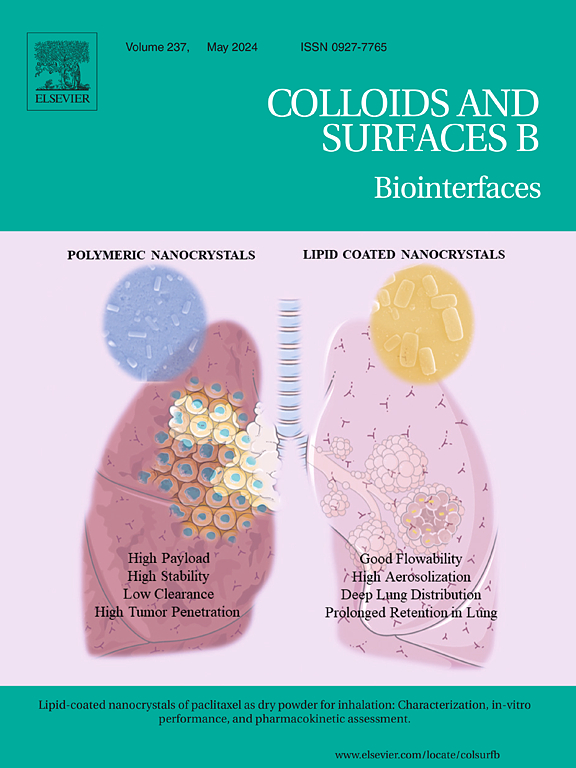Recent progress in hyaluronic acid based nanoparticles for the anti-tumor application
IF 5.4
2区 医学
Q1 BIOPHYSICS
引用次数: 0
Abstract
Traditional nano-carriers used for anti-tumor applications primarily rely on the enhanced permeability and retention (EPR) effect to achieve effective drug release and cancer therapy. However, the passive targeting mechanism of these nano-carriers often results in inadequate accumulation and unsatisfied therapeutic efficacy in tumor tissues. Therefore, the development of active targeting nano-carriers for improved therapeutic outcomes has emerged as the major focus in the anti-tumor field. Notably, hyaluronic acid (HA), as a type of natural functional biomacromolecule, has gained significant attention for its remarkable water-solubility, biocompatibility, biodegradability, and CD44-receptor mediated active targeting properties. Consequently, HA has been developed as one potential candidate for the construction of nanoparticles for drug delivery, particularly in the active targeting cancer therapy field. This paper provides a comprehensive summary of the modification of HA, HA-based nano-carriers and their applications, including chemotherapy, photothermal therapy, photodynamic therapy, chemodynamic therapy, and combined therapy. The different therapeutic mechanisms and recent advancements in HA-based nano-carriers are discussed. Additionally, based on the progress of HA-based nanoparticles, the research trends in this area are also anticipated. Overall, this paper exhibits the potential of HA-based nano-carriers in active targeting cancer therapy and provides insights into their applications and future directions in the field.
透明质酸纳米颗粒抗肿瘤研究进展
用于抗肿瘤应用的传统纳米载体主要依靠增强的渗透性和滞留性(EPR)效应来实现有效的药物释放和癌症治疗。然而,这些纳米载体的被动靶向机制往往导致其在肿瘤组织中蓄积不足,治疗效果不理想。因此,开发活性靶向纳米载体以改善治疗效果已成为抗肿瘤领域的主要焦点。值得注意的是,透明质酸(HA)作为一种天然功能性生物大分子,因其出色的水溶性、生物相容性、生物降解性和cd44受体介导的活性靶向性而备受关注。因此,透明质酸已被开发为构建用于药物递送的纳米颗粒的潜在候选者,特别是在主动靶向癌症治疗领域。本文综述了透明质酸的改性、基于透明质酸的纳米载体及其在化学疗法、光热疗法、光动力疗法、化学动力疗法和联合疗法等方面的应用。讨论了ha基纳米载体的不同治疗机制和最新进展。此外,基于ha基纳米颗粒的研究进展,展望了该领域的研究趋势。总之,本文展示了基于ha的纳米载体在主动靶向癌症治疗中的潜力,并对其在该领域的应用和未来方向提供了见解。
本文章由计算机程序翻译,如有差异,请以英文原文为准。
求助全文
约1分钟内获得全文
求助全文
来源期刊

Colloids and Surfaces B: Biointerfaces
生物-材料科学:生物材料
CiteScore
11.10
自引率
3.40%
发文量
730
审稿时长
42 days
期刊介绍:
Colloids and Surfaces B: Biointerfaces is an international journal devoted to fundamental and applied research on colloid and interfacial phenomena in relation to systems of biological origin, having particular relevance to the medical, pharmaceutical, biotechnological, food and cosmetic fields.
Submissions that: (1) deal solely with biological phenomena and do not describe the physico-chemical or colloid-chemical background and/or mechanism of the phenomena, and (2) deal solely with colloid/interfacial phenomena and do not have appropriate biological content or relevance, are outside the scope of the journal and will not be considered for publication.
The journal publishes regular research papers, reviews, short communications and invited perspective articles, called BioInterface Perspectives. The BioInterface Perspective provide researchers the opportunity to review their own work, as well as provide insight into the work of others that inspired and influenced the author. Regular articles should have a maximum total length of 6,000 words. In addition, a (combined) maximum of 8 normal-sized figures and/or tables is allowed (so for instance 3 tables and 5 figures). For multiple-panel figures each set of two panels equates to one figure. Short communications should not exceed half of the above. It is required to give on the article cover page a short statistical summary of the article listing the total number of words and tables/figures.
 求助内容:
求助内容: 应助结果提醒方式:
应助结果提醒方式:


